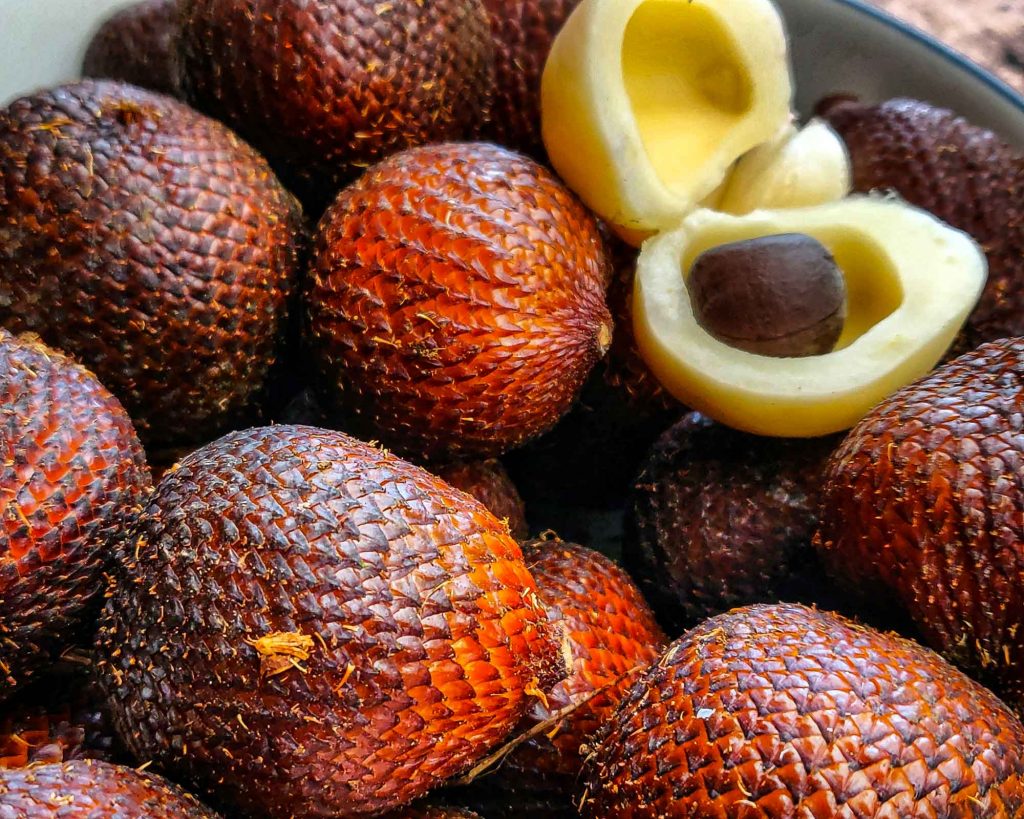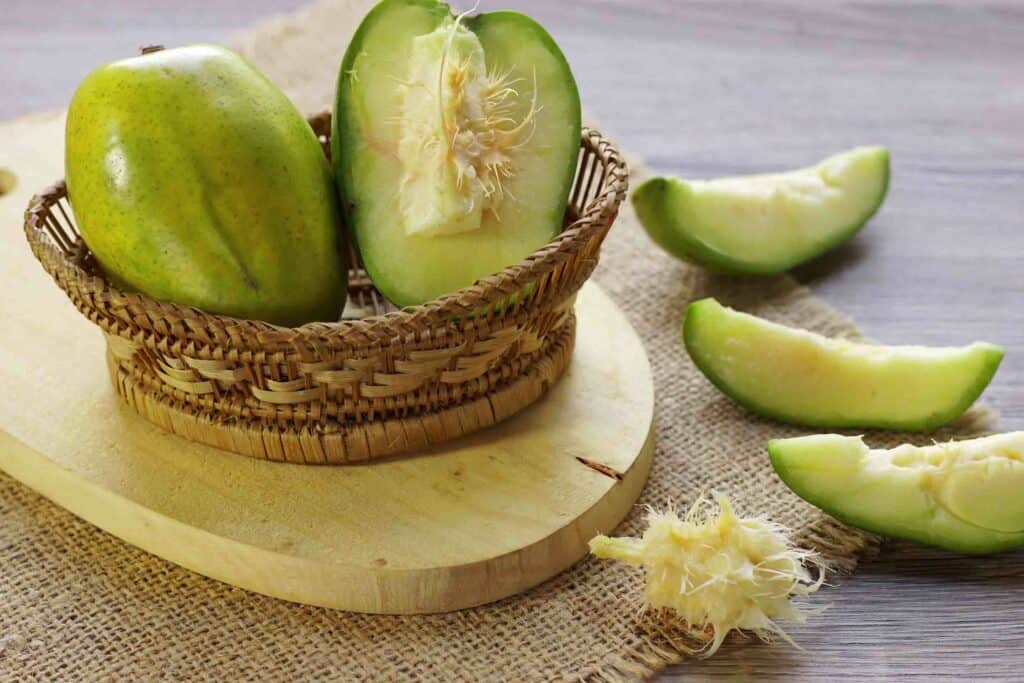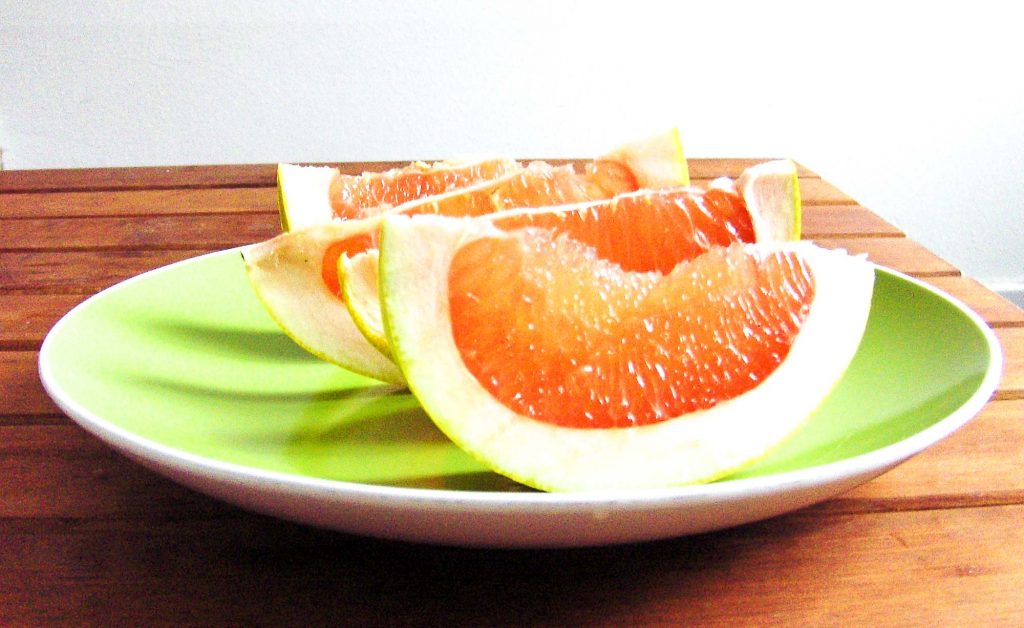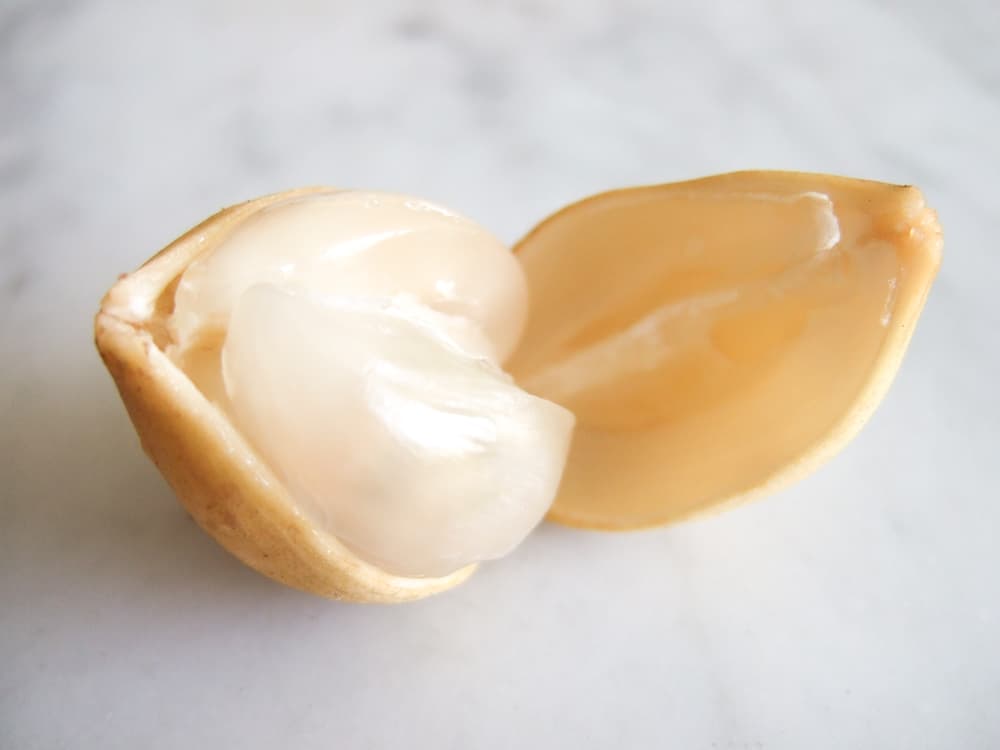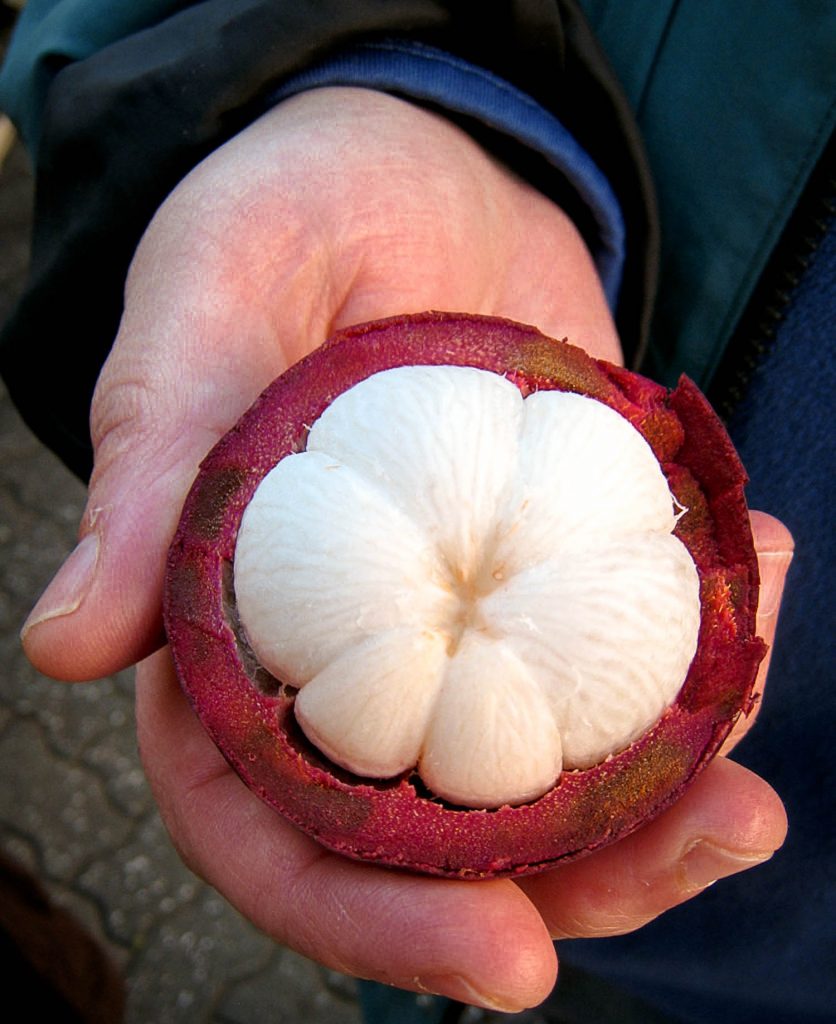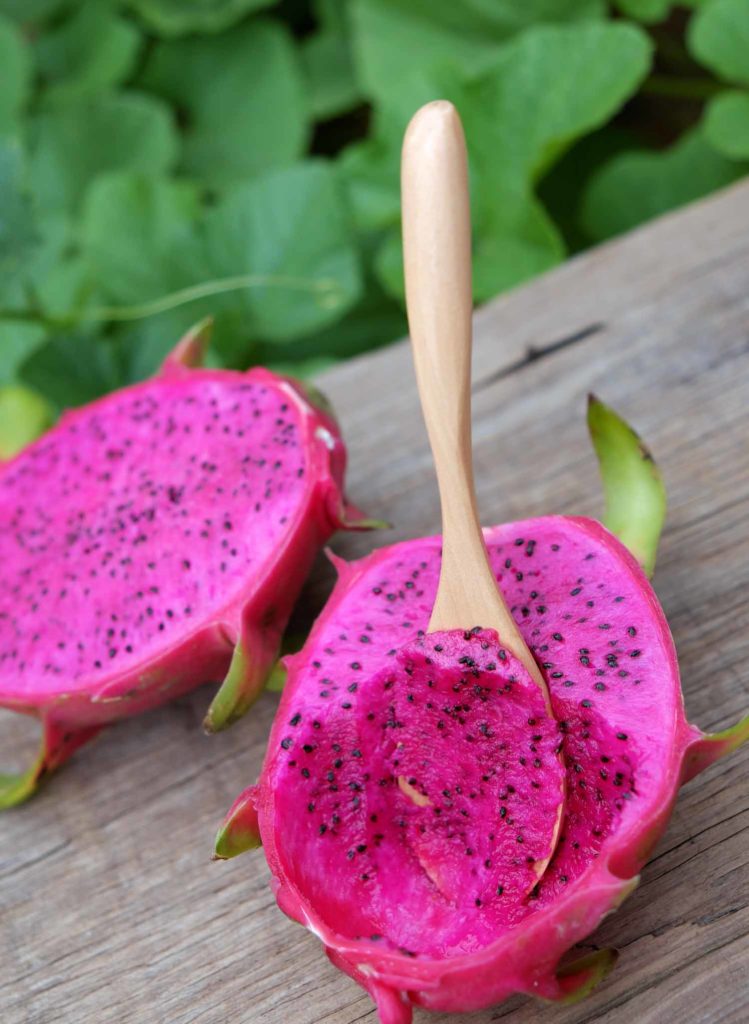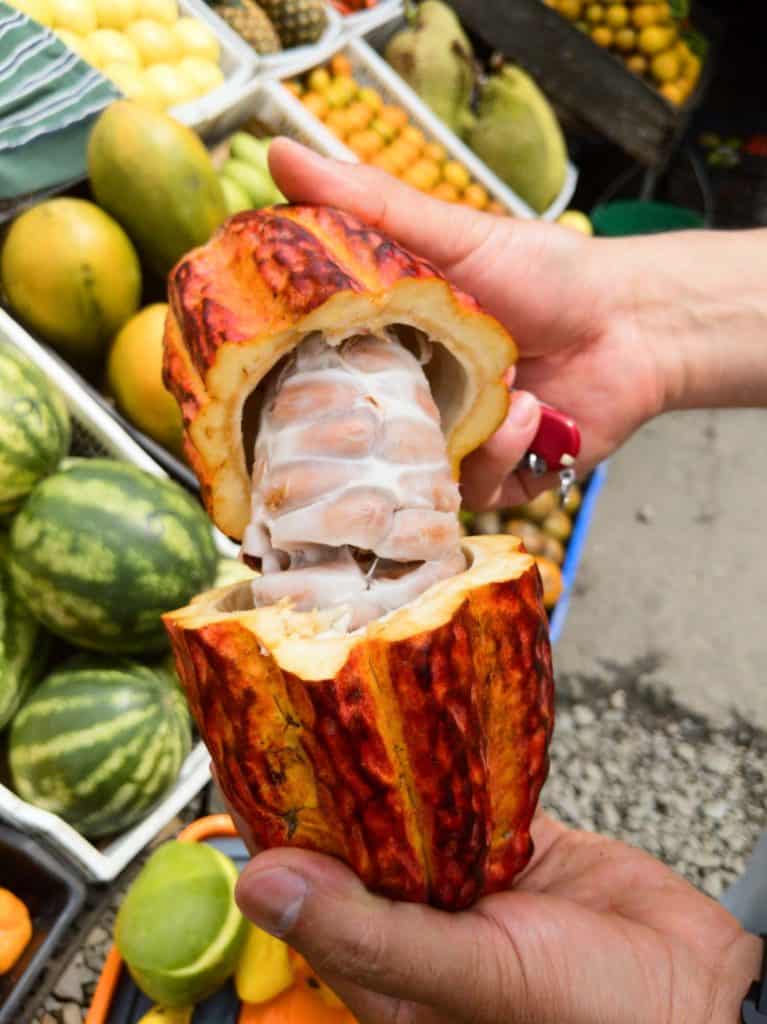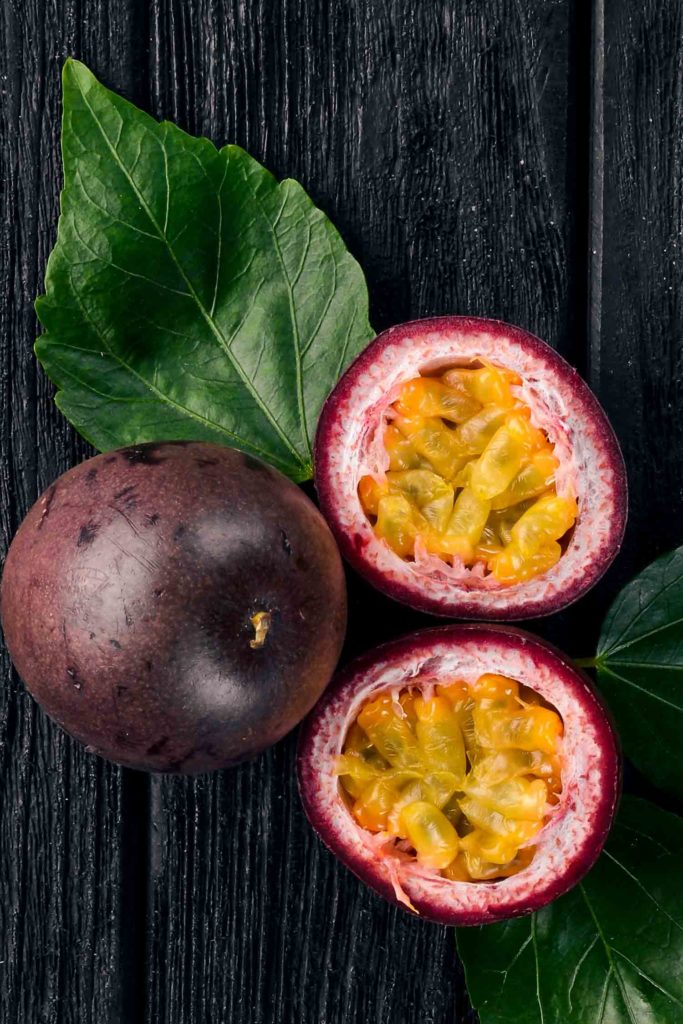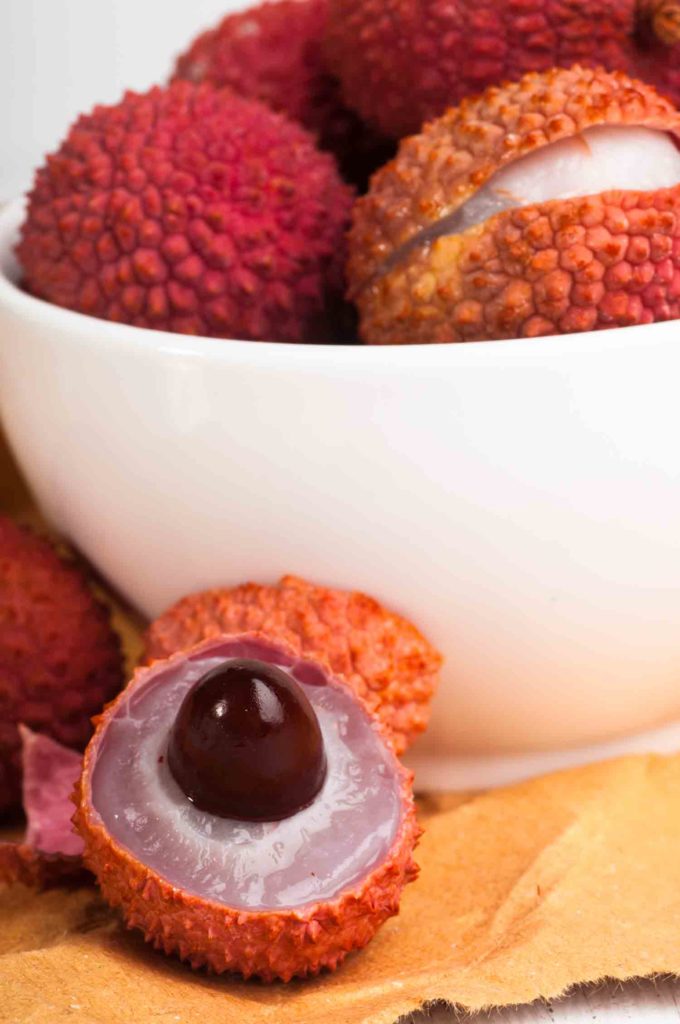Forget about apples and bananas, you’ll find tropical Bali fruits you can’t get at home.
Bali is a tropical paradise that is known for its pristine beaches, lush green forests, and ancient temples.
However, Bali is also famous for its exotic fruits. Fruit lovers will be excited the local markets and street vendors to taste some of the most delicious and unusual fruits in Bali.
Perhaps you’ve tried some of these Indonesian fruits elsewhere but I like to think even a simple banana or pineapple has a slightly different taste in each country.
And of course it always tastes better when you’re eating local fruit. Sure we can get it shipped to our home countries but it’s just not quite the same.
If you want to know what fruits are in season in Bali when you visit, below I share the exotic fruits along with their season.
BALI FRUITS YOU’LL LOVE
1. Salak | Snake Fruit
This fruit has a scaly brown exterior that resembles a snake’s skin, hence its name.
The fruit is sweet and juicy and has a slightly acidic taste that is similar to a pineapple mixed with pear and strawberry.
You can find salak all over South East Asia and I first had them in the Amazon as Ecuadorian fruits.
There are special variety of salak or snakefruit known as Salak Bali, which is specific to Bali, Indonesia.
It is highly esteemed for its unique taste and is a popular local delicacy.
Scientific Name: Salacca zalacca
Other Common Names: Salak palm, snake-fruited palm, snake-skinned fruit, Bali salak palm
Nutritional Benefits: Salak is high in vitamin C, potassium and fiber.
Salak Season in Bali: February to March
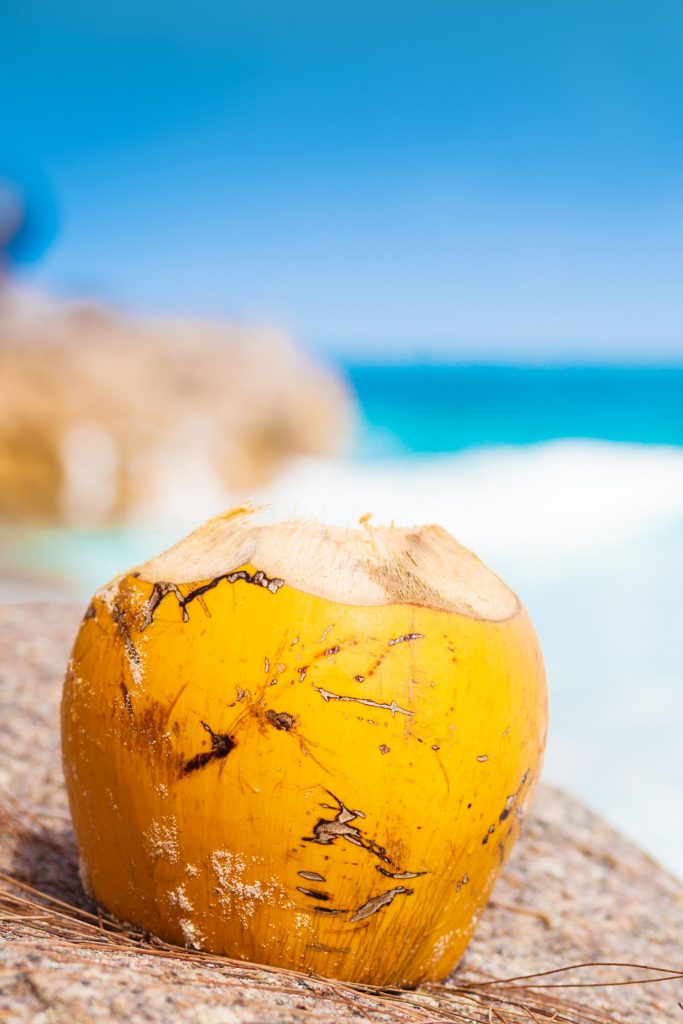
2. Nyuh Gading | Yellow or Orange Coconut
Nyuh Gading is a type of coconut that is native to Bali and is commonly used in traditional ceremonies on the island.
In other parts of Indonesia it is known as kelapa muda.
It is distinguishable by its yellow or orange color and holds cultural significance in Balinese rituals and offerings.
The unique hue of the Nyuh Gading coconut symbolizes purity and is often used in religious ceremonies and cultural practices as a symbol of reverence and respect.
Its presence adds a special touch to the spiritual and ceremonial traditions of Bali.
Scientific Name: Cocos nucifera
Other Common Names: Coco, kokonattsu, nariyal, nariyel niu, noix de coco,
Nutritional Benefits: Coconuts are high in fiber and a good source of potassium and manganese
Nyuh Gading Season in Bali: All year round
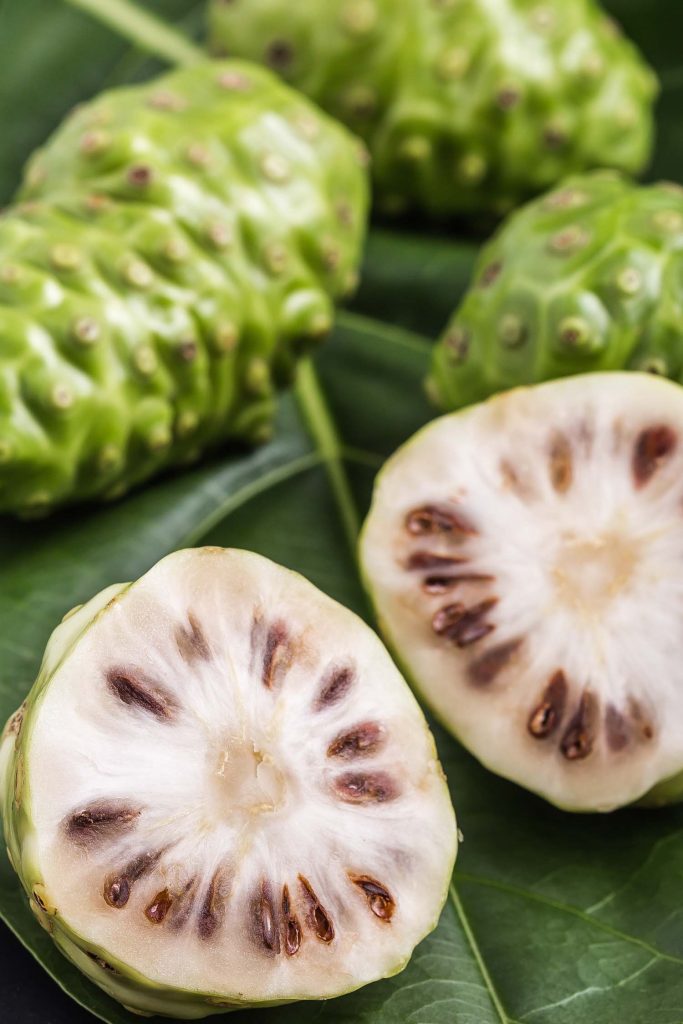
3. Megkudu | Noni
The noni fruit, commonly found in Bali, Indonesia, is a tropical fruit with a pungent odor and a bitter taste. It is green and bumpy when unripe, turning yellow or white when ripe.
It is more infamous than durian as even locals find it repugnant.
Originating from Southeast Asia and the Pacific Islands, noni fruit is also grown in regions with tropical climates. It’s a famous or maybe infamous fruit in Hawaii because of its smell.
In Bali, it is used not only in its raw form but also in traditional medicine and various culinary preparations.
You may see it in juices, jams, and as an ingredient in savory dishes, due to its reputed health benefits and unique flavor profile.
As it’s considered a miracle fruit that can cure cancer I suggest drinking it as a juice mixed with other fruits. It will help tone down the stinky feet flavor.
Scientific Name: Morinda citrifolia
Other Common Names: Great morinda, Indian mulberry
Nutritional Benefits: Rich in vitamin C, potassium, and antioxidants
Noni Season in Bali: Available year-round
4. Boni / Buah Buni
This Balinese fruit is so rare that when I was visiting Lombok with a friend from the western island of Sumatra, he had no idea what it was.
You’ll find the buni fruit in Bali. It looks a bit like a coffee bean fruit but tastes more like a grape.
Around the world boni has been used to treat anemia and heart disorders.
Scientific Name: Antidesma bunius
Other Common Names: bignay, bignai, bugnay, Chinese laurel, Queensland cherry, salamander-tree, wild cherry
Nutritional Benefits: vitamin A, vitamin C, calcium, phosphorus, iron, thiamine, riboflavin and niacin. They are high in antioxidants and anthocyanin, which gives the fruit its purplish color.
5. Kendondong | Ambarella
The kedondong fruit, also known as ambarella, is a tropical fruit found in Bali, Indonesia.
It has a green skin and a tangy, sour taste with a hint of sweetness.
It originates from from Southeast Asia and a popular fruit in Cambodia. It is also cultivated in other tropical regions such as Sri Lanka and the Caribbean.
In Bali, kedondong fruit is used in various culinary preparations, including pickles, jams, and sauces, due to its tart flavor.
It is also enjoyed in refreshing drinks and added to salads, contributing a unique and zesty taste to a wide range of dishes such as rujak kedondong which is a must eat Balinese dish.
This is another Bali fruit considered to help digestion and also anemia.
Scientific Name: Spondias dulcis
Other Common Names: Ambarella, Golden Apple, Great Hog Plum, Otaheite Apple, Jew Plum, Yellow Plum
Nutritional Benefits: Buah kedondong is high in vitamin C, potassium, and fiber.
Buah Kedondong Season in Indonesia: May to August
6. Jeruk Bali / Bali Orange
Probably better known as pomelo, it’s a citrus fruit that is often mistaken for grapefruit because of its size.
They are large fruit that can weigh several pounds hanging from the tree. So it’s not surprising that its scientific name is citrus maximus.
And while it is native to Southeast Asia and also a common fruit in Sri Lanka, it is another one of many exotic fruits brought to the Caribbean.
No one knows why is called Bali orange as it’s not from Bali, but perhaps the name was given by foreigners who first encountered it in Bali.
Balinese believe it can help in a number of ways from curing a hangover to acting as a mosquito repellant by burning the skin.
Scientific Name: Citrus maxima
Other Common Names: pomelo
Nutritional Benefits: Rich in vitamin C and antioxidants
Jeruk Bali Season in Bali: Available from November to March
7. Jeruk Siam | Kintamani Oranges
Kintamani orange, also known as tangor, temple orange, or Siamese orange, is a natural hybrid of Tangerine and Sweet Orange originating from Indochina.
Popular in Indonesia as jeruk siam, its flavor is a delightful blend of sweet and sour.
Visitors to Bangli in Bali can experience the Kintamani Orange plantation, where they have the opportunity to handpick the fruit directly from the trees.
This citrus fruit is cherished for its unique taste and is a favorite among locals and visitors alike for its refreshing and vibrant flavor.
Scientific Name: Citrus nobilis
Other Common Names: Tangor, temple orange, Siamese orange
Nutritional Benefits: Rich in vitamin C and antioxidants
Jeruk Siam Season in Bali: Available year-round
8. Durian
The King of Fruit! Durian is the national fruit of Indonesia and beloved throughout the South East Asia and a common Vietnam fruit.
In Indonesia there are over 100 varieties of durian and I have learned if you don’t like it the first time to keep going.
As a foreigner my tip is to look for bright yellow durian which tend to be sweeter.
Bali also boasts a unique Durian variety from Buleleng, known for its exceptionally sweet taste.
Durian lovers come to eat the seasonal fruit, readily available during the rainy season. The Buleleng Durian is easily found in Singaraja-Denpasar, Ambengan Village and Gitgit Village.
Whether loved or loathed for its distinct aroma, trying this challenging yet unique treat is a must-do experience in Bali, especially during the harvest season in October.
Scientific Name: Durio zibethinus
Other Common Names: Buleleng Durian
Nutritional Benefits: Rich in energy, vitamins, and minerals
Durian Season in Bali: October – February
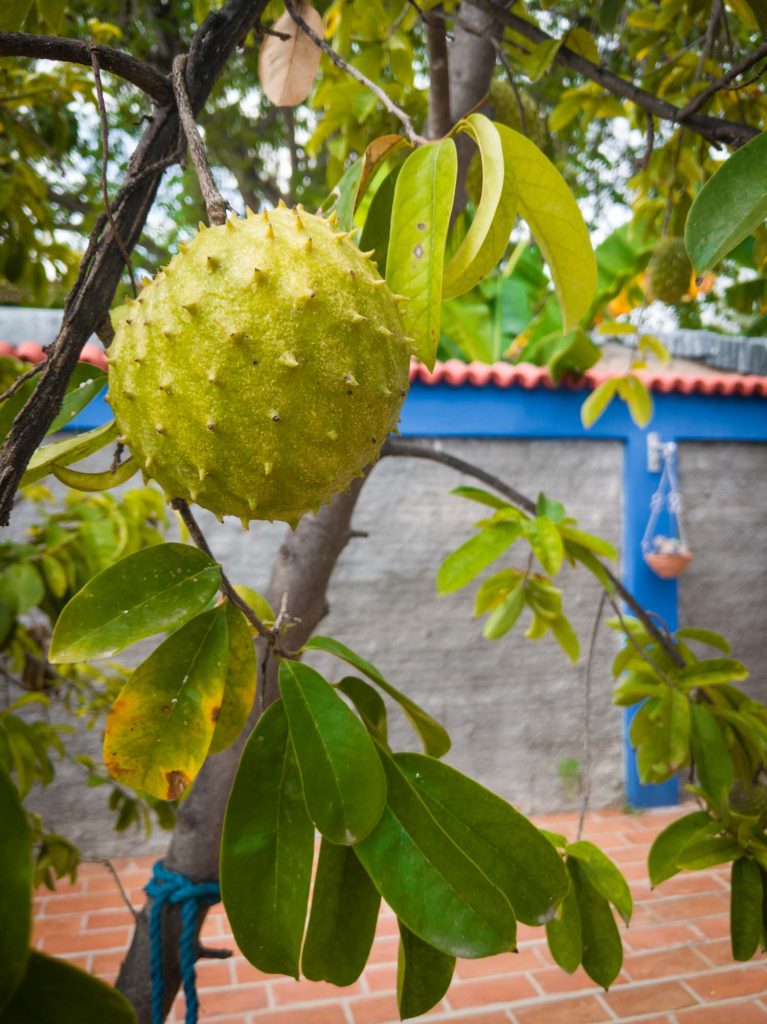
9. Sirsak | Soursop
Sirsak, also known as soursop, is a tropical fruit found in Bali, Indonesia and a great drink alongside a traditional Indonesian breakfast.
It has a prickly green exterior with soft, white flesh and large seeds inside.
The taste is a delightful blend of sweet and tangy, often likened to a mix of pineapple and strawberry with citrus undertones.
Originating from the Americas, sirsak is also cultivated in various tropical regions worldwide.
In Bali, it is used not only in its raw form but also in beverages, desserts, and traditional medicine due to its reputed health benefits and unique flavor profile.
Scientific Name: Annona muricata
Other Common Names: Soursop, Graviola
Nutritional Benefits: High in antioxidants and vitamin C
Sirsak Season in Bali: Available year-round
10. Ceroring | Langsat
Ceroring is the Balinese name for dukuk in Indonesian or langsat in English.
These tropical Bali fruits have a thin, yellowish-brown skin and translucent, juicy flesh with a sweet and slightly sour taste.
Originating from Southeast Asia, langsat is also cultivated in other tropical regions and are a popular Malaysia fruit.
Ceroring, a seasonal fruit, thrives in Bali’s Singaraja area, typically available in October.
Sold in dense bunches at markets, it must be peeled before consumption to avoid the bitter seeds.
While ripe ceroring is sweet, unripe fruit is acidic and slightly bitter. Locals believe excessive consumption may cause fever-like symptoms.
Scientific Name: Lansium parasiticum
Other Common Names: lanzones or longkong
Nutritional Benefits: Langsat is high in vitamin C, potassium, and fiber.
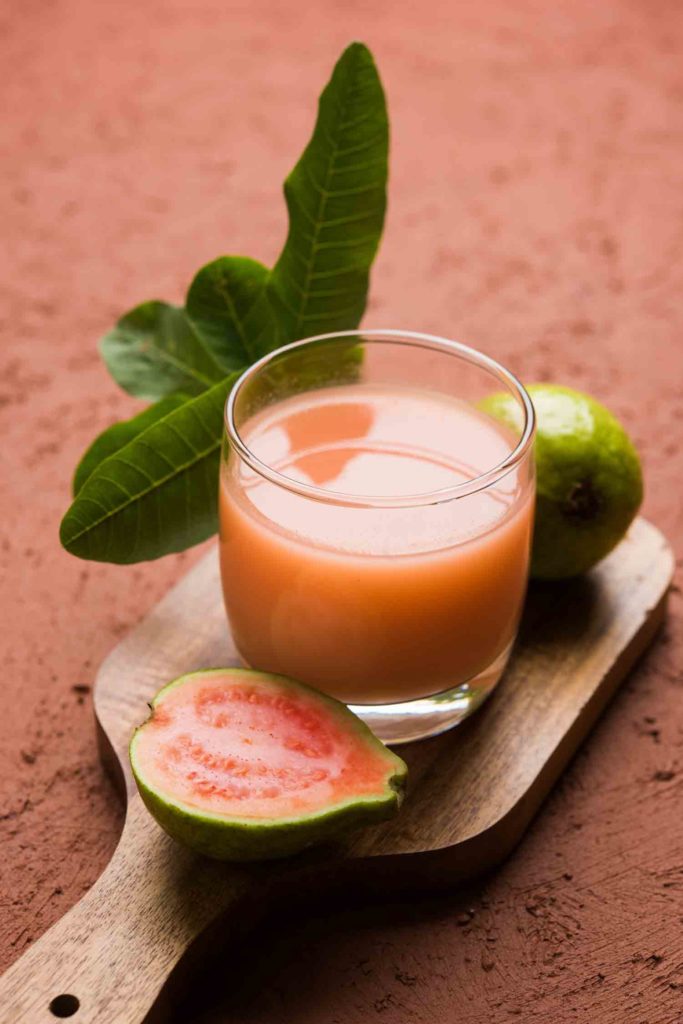
11. Jambu Biji | Guava
Jambu biji, also known as guava, is a tropical fruit in Bali, Indonesia.
It has a green or pink outer skin with sweet, juicy, and slightly crunchy flesh.
Originating from Central America, jambu biji is also cultivated in various tropical regions worldwide.
In Bali, it is used not only in its raw form but also in beverages, jams, and desserts, adding a unique flavor to culinary creations.
This versatile fruit is prized for its refreshing taste and is a popular choice for both snacking and culinary applications in Bali.
It’s also a popular Cuban fruit used in jams and desserts.
Scientific Name: Psidium guajava
Other Common Names: Amrood, farang, goiaba, guayaba,
Nutritional Benefits: Rich in vitamin C, fiber, and antioxidants
Jambu Biji Season in Bali: Year-round
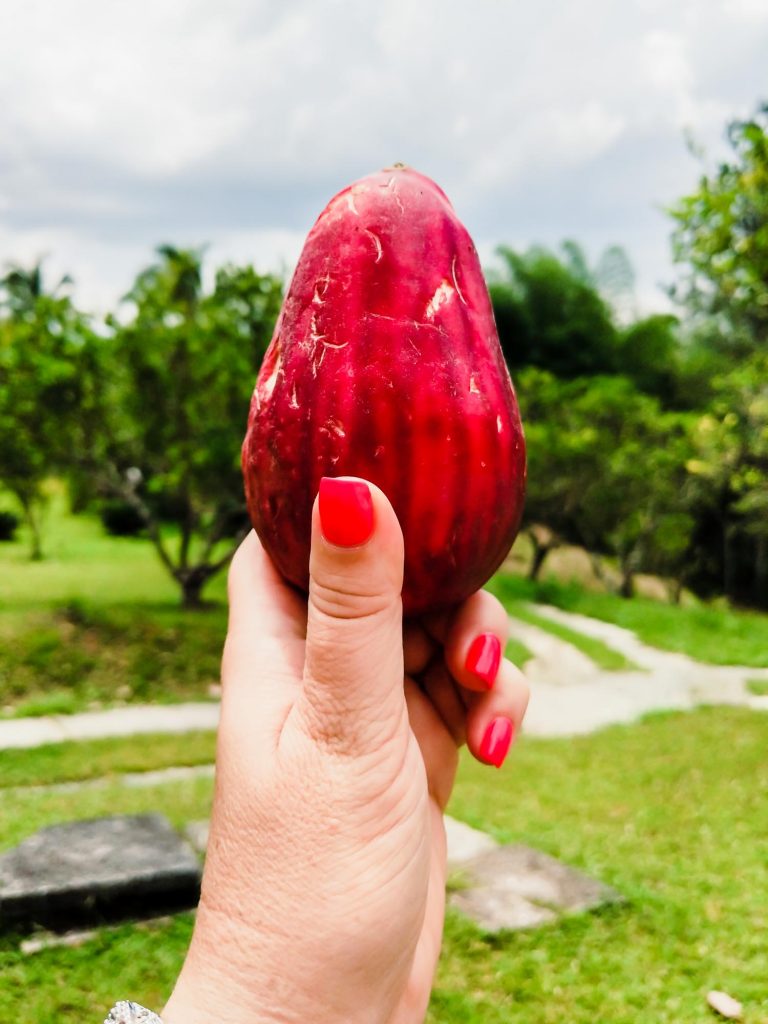
12. Jambu Air | Rose Apple
Jambu Air, also known as rose apple, is a tropical fruit found in Bali.
It is a crisp and watery fruit with a mild, floral flavor.
Originating from Southeast Asia, it is commonly found in Indonesia, Thailand, and Malaysia.
You can also find it as far as the Caribbean where it is one of the most popularJamaican fruits.
Scientific Name: Syzygium samarangense
Other Common Names: Rose apple, Java apple, Otaheite apple, Mountain Apple
Nutritional Benefits: High in vitamin C and dietary fiber
Jambu Air Season in Bali: Year-round
13. Sawo Kecik | Caqui
Sawo Kecik, also known as chiku or sapodilla but is not a native Bali fruit
It is a small, round fruit with a rough brown skin and sweet, grainy flesh.
Originating from Central America and the Caribbean, it is also found in other tropical regions such as India, the Philippines, and Malaysia.
The fruit has a unique flavor that combines elements of pear, brown sugar, and a hint of spice, making it a popular treat in Bali and beyond.
Scientific Name: Manilkara kauki
Other Common Names: Chiku, Sapodilla
Nutritional Benefits: High in dietary fiber, vitamins A and C, and minerals like potassium and iron
Sawo Kecik Season in Bali: Year-round
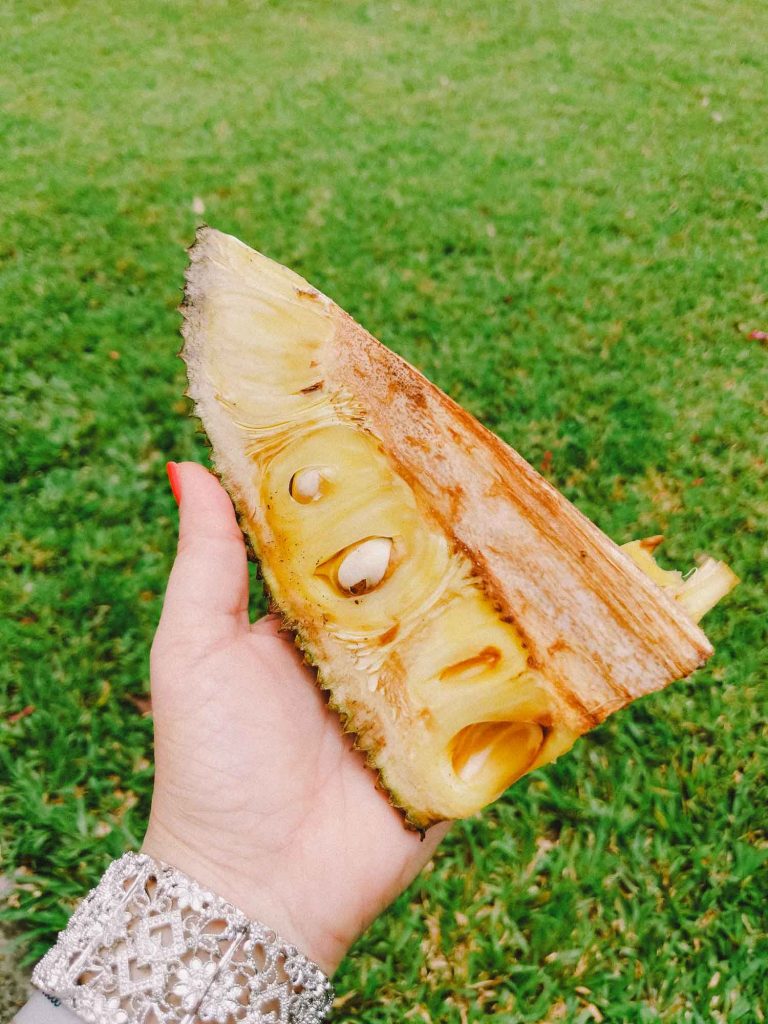
14. Nangka | Jackfruit
Jackfruit is one of my favourite Bali fruits.
It has a sweet and distinctive flavor and is so large that at the market it is usually cut into several pieces as buying a whole one could feed a neighbourhood.
When raw, it has a mildly sweet taste and a crunchy texture and is like a fruit cocktail.
Originating from the Indian subcontinent, it is widely used in cooking across Southeast Asia and in many traditional Indonesian foods like gudeg in Yogyakarta and a Padang dish called gulai cubadak.
In Bali, jackfruit is used in savory dishes like curries and stir-fries, as well as in desserts.
Its versatile nature and meaty texture make it a popular ingredient in vegetarian and vegan cuisine that all Balinese love.
It’s also popular in Central America and the Caribbean, this fruit in Trinidad and Tobago is known as cowa.
Scientific Name: Artocarpus heterophyllus
Other Common Names: Buah Pala, Jack, Jak, Jake Tree, Yaca
Nutritional Benefits: Rich in fiber, vitamins, and minerals
Jackfruit Season in Bali: Year-round
15. Manggis | Mangosteen
The mangosteen resembles a small purple apple and its hard skin can be cracked open to reveal a soft white flesh, segmented and delicious.
It offers a nice balance of sweet and tart flavors. But beware when opening the purple skin to avoid staining hands and clothes with the dark red fluid, earning it the nickname ‘blood fruit’.
In Bali, mangosteen holds a special significance, featuring in local mythologies and sayings.
It is also unique in that the number of segments can be determined by turning the fruit upside down and observing the small “flower” mark.
This revered fruit is commonly found in Bali’s markets and on vendor carts.
You can also find mangosteen all over South East Asia where it’s a popular Thai fruit, and it’s also made its way to tropical areas in the Americas.
Scientific Name: Garcinia mangostana
Other Common Names: Mangosteen, Mesetor, Sementah, Semetah
Nutritional Benefits: Mangosteen is a rich source of antioxidants, vitamins, and minerals.
Season in Bali: December to March
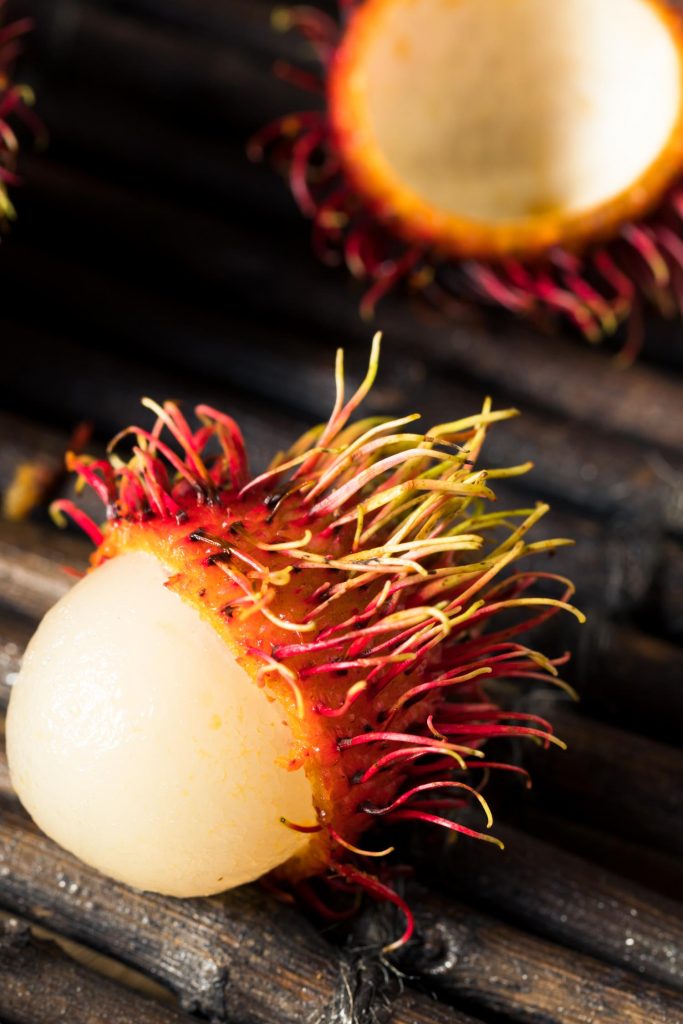
16. Buluan | Rambutan
The fruit’s name, meaning ‘hairy’, reflects its soft spiky exterior, and it is typically sold in bunches in Bali’s supermarkets and from street vendors.
Its delightful balance of sour and sweet flavors has made it a personal favorite, often likened to a strawberry lychee cocktail.
It’s one of the few Bali fruits that do not continue to ripen once picked so look for bright red vibrant fruit.
Anything too dark or dry is old and anything that isn’t quite red will be sour. Locals aren’t shy with vendors pointing to what they want or don’t want so be firm and polite.
When ripe, the flesh is sweet and juicy, similar in taste to lychee, while the inedible pit lies within the tightly clinging flesh.
You can find rambutan in Central America and it’s a popular Costa Rican fruit called mamon chino.
Scientific Name: Nephelium lappaceum
Nutritional Benefits: Rambutan is a rich source of vitamins, minerals, and antioxidants.
Rambutan Season in Bali: September – April
17. Naga / Dragon Fruit
Dragonfruit, also known as pitaya or strawberry pear, is a tropical fruit with vibrant pink or yellow skin and a speckled, seedy interior.
Originating from the Americas it’s common in most countries and a popular Nicaraguan fruit. Today it is now widely cultivated in Southeast Asia, including Bali.
When eaten raw, the fruit has a mildly sweet flavor reminiscent of a cross between a kiwi and a pear, with a texture similar to a melon.
Its striking appearance and refreshing taste make it a popular choice for both culinary and decorative purposes.
Scientific Name: Hylocereus undatus
Other Common Names: Pitaya, Strawberry Pear
Nutritional Benefits: Rich in antioxidants, fiber, and vitamin C
Dragonfruit Season in Bali: December to May
18. Cacao Fruit
Bali cacao, also known as cocoa, is a tropical fruit cultivated for its seeds, which are used to produce chocolate.
The fruit has a sweet and tangy flavor, and the raw seeds have a slightly bitter taste.
Originating from Central and South America, cacao is now grown in various tropical regions, including Bali.
The seeds are fermented, dried, and processed to create chocolate products, contributing to Bali’s reputation for producing high-quality cacao-based goods.
But if you eat cacao fruit raw it tastes nothing like chocolate and is the most incredible fruit cocktail.
I first tried cacao fruit while at a working fruit plantation in Jamaica and it’s one of the most famous Jamaican fruits with coffee exported internationally.
If you see these Bali fruits at a fruit stand pay whatever it costs for this experience.
Scientific Name: Theobroma cacao
Other Common Names: Coklat
Nutritional Benefits: Rich in antioxidants, minerals, and flavonoids
Cacao Fruit Season in Bali: Year-round
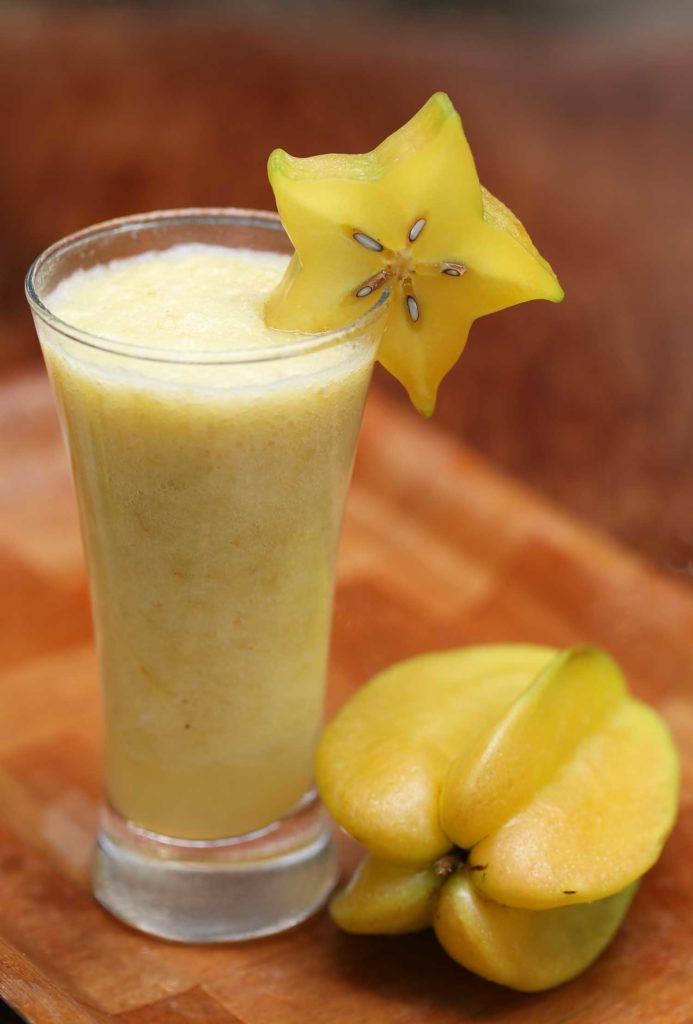
19. Belimbing | Starfruit
Starfruit, found in Bali, is a tropical fruit with a distinctive star-like shape when sliced.
It has a sweet and tangy flavor, often compared to a combination of citrus fruits and apples.
Originating from Indonesia, Malaysia, and the Philippines, starfruit is widely cultivated in tropical regions.
Today, you can find it as a popular Mexican fruit, Guatemalan fruit and known throughout Latin America as carambola.
When eaten raw, its crisp and juicy texture, along with its unique flavor profile, makes it a popular choice for fresh consumption, as well as in salads, juices, and preserves.
Scientific Name: Averrhoa carambola
Other Common Names: Carambola, Caramba, Country Gooseberry, Kamrak, Kembola,
Nutritional Benefits: Belimbing is high in vitamin C, potassium, and fiber.
Belimbing Season in Bali: May to August
20. Wani Bali | Balinese White Mango
Mangifera caesia, commonly known as Jack or Binjai, is a tropical fruit in Bali that is part of the cashew family.
It looks like a regular mango but is white inside. has a sweet and tangy flavor with a hint of sourness when eaten raw.
Originating from Southeast Asia, particularly Malaysia and Indonesia, the fruit is known for its juicy, fibrous flesh and unique aroma.
It is often enjoyed fresh or used in various culinary applications, including jams, chutneys, and desserts, contributing to its popularity in Bali and neighboring regions.
Scientific Name: Mangifera Caesia Jack
Common names: Jack, Binjai, Bayuno, Beluno, Binglu, Bin-Ya, Palong, binglu, Sedaman, Lam-Yaa
White Mango Season: December to March
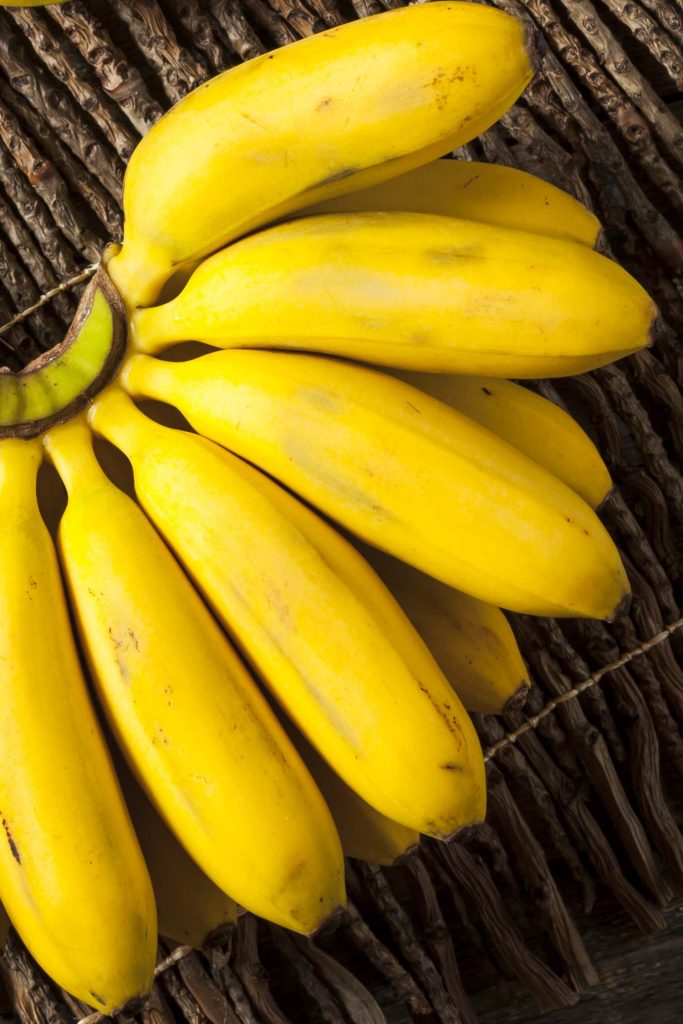
21. Biu | Banana
Bananas are not one of the most exotic Bali fruits. However eating a banana in the place it was grown tastes completely different than our home countries.
There are a number of different varieties of banana in Bali, even the Cavendish will taste better.
But you cannot leave without trying pisang susu or milk bananas. They are the shorter, stubby round bananas and so sweet.
Similar to the Colombian fruit banana bocadillo, you need to try these small bananas for yourself.
Scientific Name: Musa
Other Common Names: banane, kluai, chuối
Nutritional Benefits: Banana is rich in potassium, fiber and vitamins B and C.
Banana Season in Bali: All Year Round
22. Markisa | Passion Fruit
Passion fruit is a tropical fruit in Bali. It features a tough outer rind and juicy, seed-filled interior with a unique sweet-tart flavor.
Originating from South America, particularly Brazil and Paraguay. It’s also a common and passion fruit is now widely cultivated in tropical and subtropical regions.
When eaten raw, its aromatic, tangy taste and refreshing juiciness that is like pear, peach and strawberry.
Scientific name: Passiflora edulis
Other Common Names: maracuyá, maracujá
Nutritional Benefits: Rich in vitamins, fiber, and antioxidants
Passion Fruit Season in Bali: Year-round
23. Mangga | Mango
One of the most popular fruits in the world, mango is Bali is such a treat.
In Bali, popular mango varieties include the gedong, arumanis, and manalagi.
When eaten raw, mangoes have a sweet, juicy, and tropical flavor with varying degrees of tanginess.
Originating from South Asia, particularly India, mangoes are now widely cultivated in tropical and subtropical regions worldwide.
Personally I think some of the best mangos are the Filipino fruits, but I may be biased because they are the first mangoes I had eaten where they were grown.
Scientific Name: Mangifera indica
Nutritional Benefits: Rich in vitamins A and C, dietary fiber, and antioxidants
Mango Season in Bali: October to February
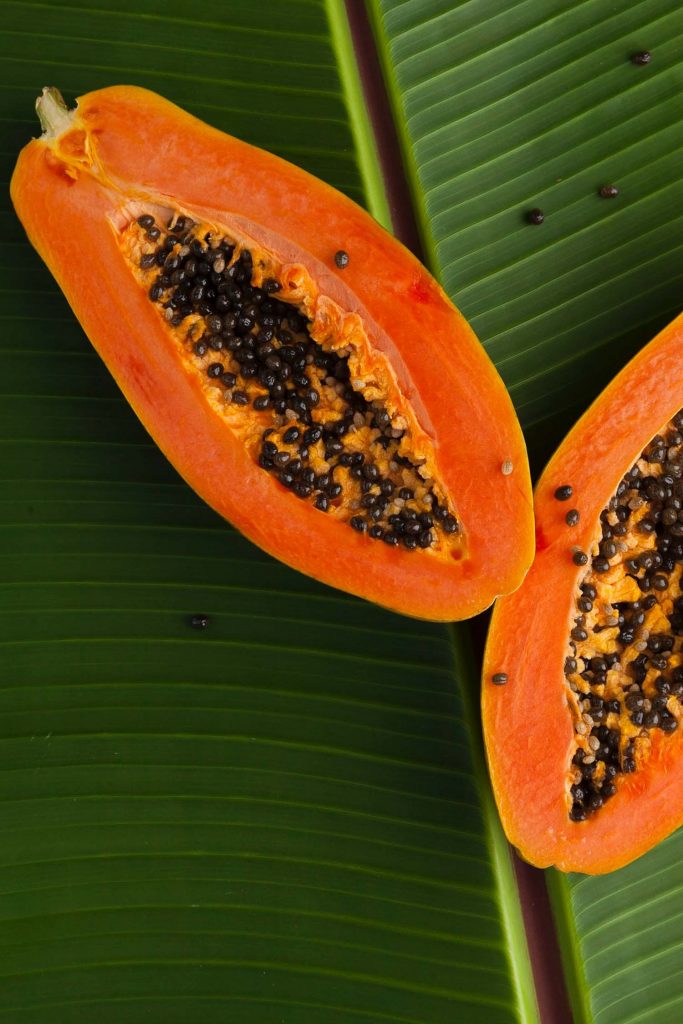
24. Papaya
In Bali, popular papaya varieties include the Hawaiian and Mexican types. When eaten raw, papayas have a sweet and musky flavor with a buttery texture.
Originating from Central America and Southern Mexico, papayas are now cultivated in tropical regions worldwide, including Bali.
The fruit is known for its rich orange flesh and versatility in culinary applications, often enjoyed fresh, in salads, smoothies and as a tenderizing ingredient in meat marinades.
Scientific Name: Carica papaya
Other Common Names: fruita bomba, lechosa, pawpaw
Nutritional Benefits: Rich in vitamins A and C, fiber, and antioxidants
Papaya Fruit Season in Bali: Year-round
25. Semangka | Watermelon
One of the most refreshing fruits in Bali on a hot day. It’s not a rare fruit, you can find watermelon all over the world. These fruits in Panama are called sandia and just as common as Bali.
But here in Bali you can try the yellow watermelon. If you’ve never tried the yellow watermelon spend a bit more to try it.
Personally I think yellow watermelon tastes like red watermelon. But it’s fun to try.
Scientific Name: Citrullus lanatus
Other Common Names: pastèque, sandia, tarbooj
Nutritional Benefits: Hydrating, rich in vitamins A and C, and contains antioxidants
Watermelon Season in Bali: Year-round
26. Leci | Lychee
Most westerners know of lychee in cocktails but have never tried it raw. But lychee are common fruits in Bali and sold in the market.
Lychee has a sweet, floral flavor and a juicy, translucent flesh.
Originating from China, it is now cultivated in various tropical regions and are now common South American fruits.
When eaten raw, lychee offers a delightful balance of sweetness and tartness, with a unique perfume-like aroma, making it a popular snack on this beautiful island.
27. Nanas | Pineapple
Pineapples are another Bali fruit that aren’t the most exotic tropical fruit but so delicious.
In Bali, popular pineapple varieties include the MD2 and N36. These pineapples have a sweet, juicy, and tangy flavor with vibrant tropical notes.
Originating from South America, particularly Paraguay and southern Brazilian fruits, pineapples are now cultivated in tropical regions worldwide, including Bali.
Scientific Name: Ananas comosus
Other Common Names: ananas, piña
Nutritional Benefits: Rich in vitamin C, manganese, and antioxidants
Pineapple Season in Bali: Year-round
